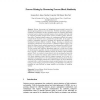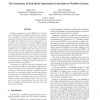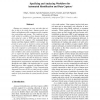DEXA
2004
Springer
14 years 3 months ago
2004
Springer
Abstract. Workflow management systems (WFMS) coordinate execution of multiple tasks performed by different entities within an organization. In order to coordinate the execution of ...
BPM
2006
Springer
14 years 3 months ago
2006
Springer
Mining, discovering, and integrating process-oriented services has attracted growing attention in the recent year. Workflow precedence graph and workflow block structures are two i...
CSFW
2004
IEEE
14 years 3 months ago
2004
IEEE
Workflow management systems (WFMSs) have attracted a lot of interest both in academia and the business community. A workflow consists of a collection of tasks that are organized t...
COOPIS
2004
IEEE
14 years 3 months ago
2004
IEEE
Previous workflow mining works have concentrated their efforts on process behavioral aspects. Although powerful, these proposals are found lacking in functionalities and performanc...
APN
2006
Springer
14 years 3 months ago
2006
Springer
We consider nested nets, i.e. Petri nets in which tokens can be Petri nets themselves. We study value semantics of nested nets rather than reference semantics, and apply nested ne...
APWEB
2004
Springer
14 years 3 months ago
2004
Springer
Abstract. Although most existing teamwork management systems support userfriendly interface to some extent, few of them have take into consideration of the special requirements of ...
HICSS
2009
IEEE
14 years 3 months ago
2009
IEEE
Humans use computers to carry out tasks that neither is able to do easily alone: humans provide eyes, hands, and judgment while computers provide computation, networking, and stor...
GROUP
2007
ACM
14 years 3 months ago
2007
ACM
This work presents experiences with the adopting of a workflow management system in a large financial institution. We describe the gradual evolution of a traditional work process,...
ESORICS
2007
Springer
14 years 3 months ago
2007
Springer
We propose the role-and-relation-based access control (R2 BAC) model for workflow systems. In R2 BAC, in addition to a user's role memberships, the user's relationships w...
CCGRID
2009
IEEE
14 years 3 months ago
2009
IEEE
From personal software to advanced systems, caching mechanisms have steadfastly been a ubiquitous means for reducing workloads. It is no surprise, then, that under the grid and clu...



